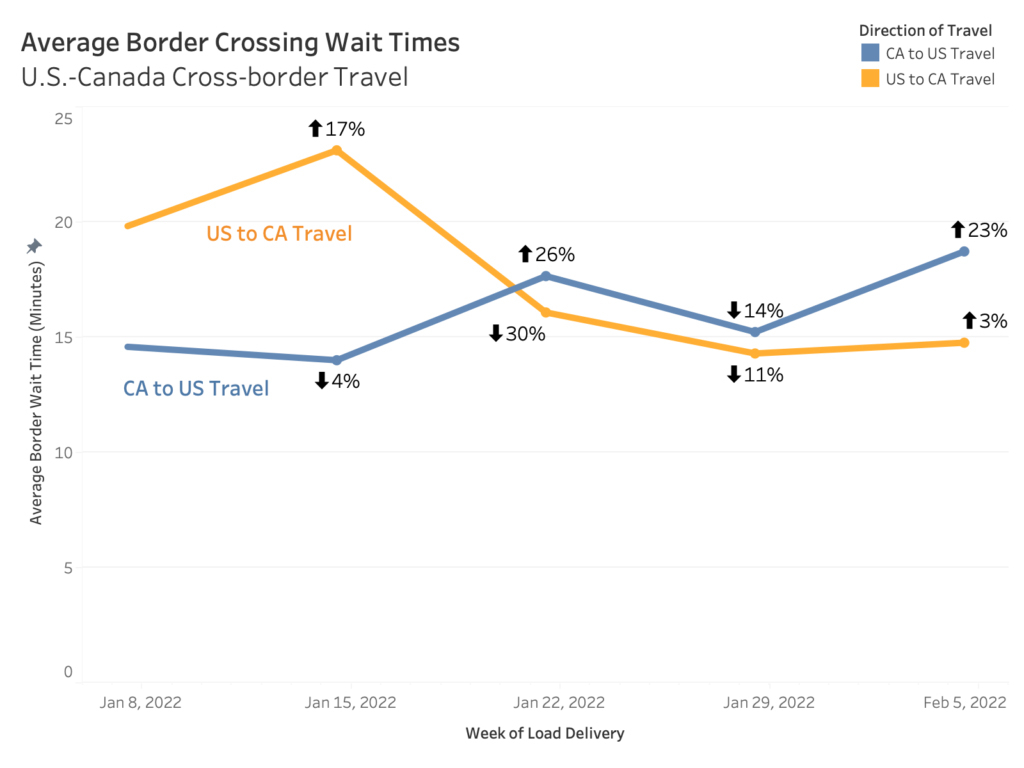Data From FourKites Shows Canadian Antivax Trucker Protest Had Limited Impact on Supply Chain
Average wait times between the US and Canada increased 17% in mid-January, followed by 26% at the end of the month
The latest data from FourKites illustrates the vaccine mandates’ and subsequent protests’ impacts on shipping volumes and on-time deliveries had some effect, but no major disruption to the U.S. or Canadian economy or trucking market.
Average wait times between the US and Canada increased 17% in mid-January, followed by 26% at the end of the month. As of 10 February wait times for Canada to US travel were trending up at 23%, while US to Canada travel was trending up by more than 40% for Monday/Tuesday shipments compared to Monday/Tuesday of the previous week. This has all translated into volatility in on-time delivery, which as of 8 February was trending down slightly for Canada to US travel, and down almost 10% for US to Canada travel for Monday/Tuesday shipments, compared to Monday/Tuesday of the previous week.
There was a significant decrease in shipping volume across the border in Mid-to-late January, with back-to-back decreases of 7% the weeks of 15 January and 22 January. As of mid-February, US-bound truck shipments from Canada have bounced back up around 23% — likely a result of Canadian exporters trying to expedite freight stranded by protests as well as winter storms. US-to-Canada travel has also rebounded by 15%.
Downstream Impacts
While FourKites haven’t yet seen far-reaching impacts across Canada or the US, the situation remains volatile near the border. Notably, the Ambassador Bridge linking Detroit and Windsor, Ontario was closed for nearly a week. This bridge handles around 8,000 trucks a day – about 25% of US-Canada trade – meaning its closure had an outsized impact.
The closure pushed costs higher, with truckload spot rates shooting up. If additional protests cause disruption for an extended period, FourKites may see more of an impact on intra-Canadian truckload pricing and a slight impact to US pricing.
The number of rerouted trucks also increased for both Canada-US and US-Canada travel. At the peak of disruptions on 8 February, trucks going both directions were traveling up to 9% farther to cover the same ground as before the protests. Since then, the distance travelled has reduced to 2% higher than the pre-mandate average for Canada to the US, and 4% higher than the pre-mandate average from the US to Canada.
Hope for Resolution?
While the bottleneck caused by the closure of the Ambassador Bridge has been resolved, the protests and delays continue to spread, prompting stakeholders up and down the supply chain to fill the gaps. And shippers are exercising lessons they have learned time and time again over the past two years to remain agile and mitigate impact. Those companies with real-time visibility into their shipments are the best equipped to react quickly – being alerted of possible delays, communicating across their networks and finding alternate shipping routes to keep goods flowing.
Category: Connected Fleet News, Driver Stuff, Equipment, Featured, Fleet Tracking, General Update, Management, News, Transit News











